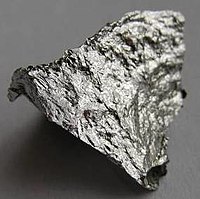
Photo from wikipedia
The oxygen evolution reaction (OER; 2H2O → O2 + 4H+ + 4e–) is being intensively studied to generate fossil fuel-independent energy carriers. As 4d/5d rare metal catalysts, such as amorphous… Click to show full abstract
The oxygen evolution reaction (OER; 2H2O → O2 + 4H+ + 4e–) is being intensively studied to generate fossil fuel-independent energy carriers. As 4d/5d rare metal catalysts, such as amorphous iridium oxide (IrOx), display higher activity than 3d metal catalysts, elucidating the critical mechanistic differences between these materials is important for the synthesis of cost-effective OER catalysts. Although most studies of OER catalysts have focused on O–O bond formation energetics, here, we examined the OER mechanism of IrOx based on charge accumulation, which was recently shown to determine the OER activity for Mn and Fe oxides. Kinetic analysis using Tafel and trumpet plots, along with the difference in the pH dependence between the OER onset potential and that of iridium valence change, showed that the valence change of iridium is more favorable than O–O bond formation. In situ evanescent wave spectroscopy revealed that an intermediate assignable to Ir5+ with oxygen ligands in opposite spin serves as the ...
Journal Title: Journal of Physical Chemistry C
Year Published: 2017
Link to full text (if available)
Share on Social Media: Sign Up to like & get
recommendations!